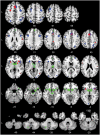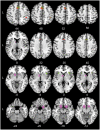Brain networks of perceptual decision-making: an fMRI ALE meta-analysis
- PMID: 24994979
- PMCID: PMC4063192
- DOI: 10.3389/fnhum.2014.00445
Brain networks of perceptual decision-making: an fMRI ALE meta-analysis
Erratum in
-
Corrigendum: Brain networks of perceptual decision-making: an fMRI ALE meta-analysis.Front Hum Neurosci. 2017 Mar 22;11:139. doi: 10.3389/fnhum.2017.00139. eCollection 2017. Front Hum Neurosci. 2017. PMID: 28337136 Free PMC article.
Abstract
In the recent perceptual decision-making literature, a fronto-parietal network is typically reported to primarily represent the neural substrate of human perceptual decision-making. However, the view that only cortical areas are involved in perceptual decision-making has been challenged by several neurocomputational models which all argue that the basal ganglia play an essential role in perceptual decisions. To consolidate these different views, we conducted an Activation Likelihood Estimation (ALE) meta-analysis on the existing neuroimaging literature. The results argue in favor of the involvement of a frontal-parietal network in general perceptual decision-making that is possibly complemented by the basal ganglia, and modulated in substantial parts by task difficulty. In contrast, expectation of reward, an important aspect of many decision-making processes, shows almost no overlap with the general perceptual decision-making network.
Keywords: decision-making; fronto-parietal-basal ganglia; meta-analysis.
Figures



Similar articles
-
Corrigendum: Brain networks of perceptual decision-making: an fMRI ALE meta-analysis.Front Hum Neurosci. 2017 Mar 22;11:139. doi: 10.3389/fnhum.2017.00139. eCollection 2017. Front Hum Neurosci. 2017. PMID: 28337136 Free PMC article.
-
Perceptual and categorical decision making: goal-relevant representation of two domains at different levels of abstraction.J Neurophysiol. 2017 Jun 1;117(6):2088-2103. doi: 10.1152/jn.00512.2016. Epub 2017 Mar 1. J Neurophysiol. 2017. PMID: 28250149 Free PMC article.
-
Perceptual decision neurosciences - a model-based review.Neuroscience. 2014 Sep 26;277:872-84. doi: 10.1016/j.neuroscience.2014.07.031. Epub 2014 Jul 29. Neuroscience. 2014. PMID: 25080159 Review.
-
Interactions between the anterior cingulate-insula network and the fronto-parietal network during perceptual decision-making.Neuroimage. 2017 May 15;152:381-389. doi: 10.1016/j.neuroimage.2017.03.014. Epub 2017 Mar 8. Neuroimage. 2017. PMID: 28284798
-
The Neural Mechanism of Long-Term Motor Training Affecting Athletes' Decision-Making Function: An Activation Likelihood Estimation Meta-Analysis.Front Hum Neurosci. 2022 Apr 13;16:854692. doi: 10.3389/fnhum.2022.854692. eCollection 2022. Front Hum Neurosci. 2022. PMID: 35517985 Free PMC article.
Cited by
-
The ICCAM platform study: An experimental medicine platform for evaluating new drugs for relapse prevention in addiction. Part B: fMRI description.J Psychopharmacol. 2017 Jan;31(1):3-16. doi: 10.1177/0269881116668592. Epub 2016 Oct 4. J Psychopharmacol. 2017. PMID: 27703042 Free PMC article.
-
Reflection impulsivity perceptual decision-making in patients with restless legs syndrome.Ann Clin Transl Neurol. 2018 Jan 30;5(3):315-322. doi: 10.1002/acn3.535. eCollection 2018 Mar. Ann Clin Transl Neurol. 2018. PMID: 29560376 Free PMC article.
-
Interactions between phasic alerting and consciousness in the fronto-striatal network.Sci Rep. 2016 Aug 24;6:31868. doi: 10.1038/srep31868. Sci Rep. 2016. PMID: 27555378 Free PMC article.
-
Linking Subclinical Autistic Traits and Perceptual Category Learning.Eur J Neurosci. 2025 Feb;61(4):e70000. doi: 10.1111/ejn.70000. Eur J Neurosci. 2025. PMID: 39957480 Free PMC article.
-
A two-layered diffusion model traces the dynamics of information processing in the valuation-and-choice circuit of decision making.Comput Intell Neurosci. 2014;2014:383790. doi: 10.1155/2014/383790. Epub 2014 Aug 31. Comput Intell Neurosci. 2014. PMID: 25254039 Free PMC article.
References
LinkOut - more resources
Full Text Sources
Other Literature Sources

